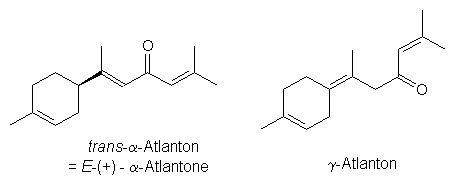![]()
Andere Namen: engl.: atlantone
CAS-Nr.: [32207-08-02]
"I see that my favourite Cedarwood is amongst the offers. HIMALAYAN CEDARWOOD (Cedrus deodora) is a most beautiful tree, growing to a height of fifty metres, which for many years some taxonomists considered to be a variety of the "Cedar of Lebanon" (Cedrus libani). Perhaps it was the presence of a- and g-atlantone, two isomeric monocyclic sesquiterpene ketones which also occur in Atlas Cedarwood (Cedrus atlantica), which is related to the Lebanon Cedar, which caused the confusion. Having no specific references to the medicinal properties of Himalayan Cedarwood, I shall rely upon the traditional uses for Atlas Cedarwood. In North Africa, oil of Atlas Cedarwood has long been used, both externally and internally, against all kinds of diseases (bronchitis, tuberculosis, skin diseases, etc.). At one time I understand that it was employed as a substitute for East Indian Sandalwood (Santalum album), particularly in the treatment of gonorrhea."
Vorkommen, Gewinnung:
Die Atlantone sind typische, geruchsgebende Bestandteile der ätherischen Öle verschiedener Cedernholzarten. Beispiele sind Atlas-Cedernholzöl, gewonnen aus Cedrus atlantica (ENDL.) MINETTI ex CARR. (Pinaceae), sowie Himalaya-Cedernholzöl, destilliert aus der Art Cedrus deodara D. DON) G. DON (= Deodaröl). Diese Essenzen sind aufgrund ihrer langanhaltenden holzigen Untertöne ausgezeichnete Fixateure in der Parfümerie, wobei sich das Himalayaöl durch eine zusätzliche "animalische" Nuance auszeichnet. Daneben wird alpha-Atlanton als Spurenkomponente im Rhizom von Curcuma longa L. (Zingiberaceae) angegeben [2].
Chemische und physikalische Kenndaten:
Strukturformeln von trans-alpha-Atlanton und von gamma-Atlanton:

Beschreibung:
Klare, viskose Flüssigkeiten, die in Wasser schwer löslich sind, mit hohem Brechungsindex.
Duftqualität:
Der Geruch ist süßlich-aromatisch, mit angenehmem, langanhaltendem Holzton.
Verwendung:
Atlanton wird in der Parfümerie praktisch nicht in Form der Substanz selbst, sondern als natürlicher Bestandteil der oben genannten Cedernholzöle eingesetzt. Anwendungsgebiete dafür sind Seifenparfums, Kompositionen der Richtungen Ambra, Farn, Mimose sowie Parfums mit erwünschter Holznote.
![]()
© 1999-2000 by Peter Rau, Neckarwestheim
Erstellt am 26.04.1999 * Letzte Änderung am 16.02.2000
Zurück zur Inhaltsübersicht
Zurück zur Homepage